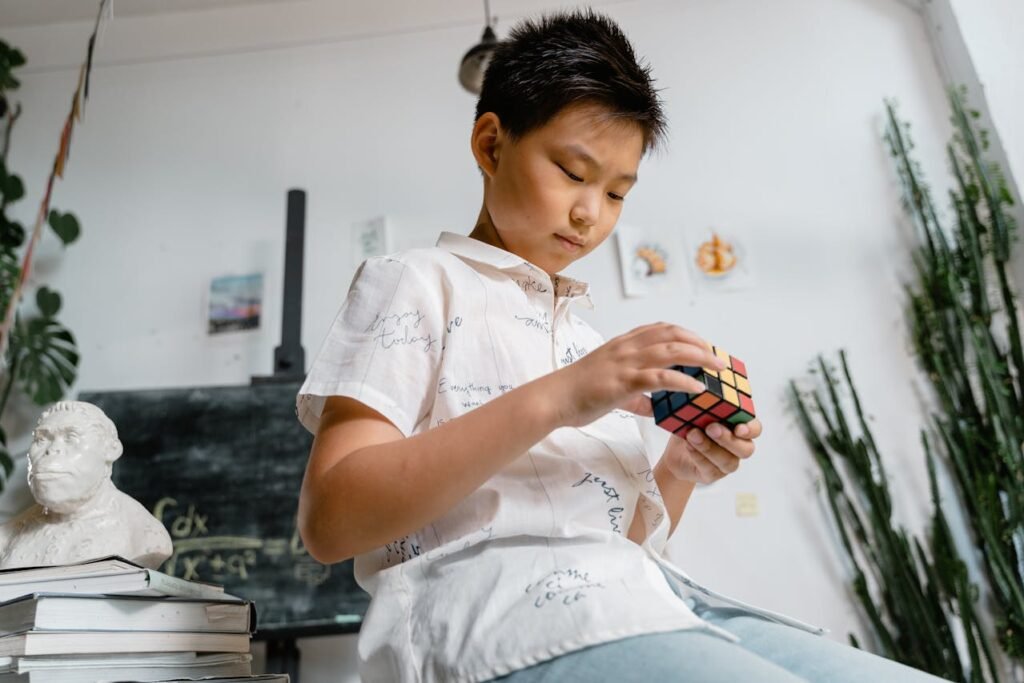Math is not just numbers on a page. It’s the way we measure, solve, and understand the world around us. But for many children, math can feel tricky, slow, or even boring—especially when it’s taught in the same old way.
That’s where AI tools like ChatGPT can change everything. Instead of making kids learn from a single textbook page, AI can talk to them, answer their questions in real time, and explain ideas in a way they actually understand. It’s like having a patient, friendly tutor who never gets tired and is always ready to help.
In this guide, we’ll explore how parents and teachers can use ChatGPT to make math lessons clearer, faster, and more fun. We’ll go step by step—from setting it up for your child to using it for real problem-solving—so you can turn math from a struggle into a skill they enjoy.
Why AI Tools Like ChatGPT Work So Well for Teaching Math
When a child struggles with math, it’s rarely because they “just can’t do it.” More often, it’s because the explanation they’re hearing doesn’t connect with how their brain processes information.
Maybe they need more visuals. Maybe they need smaller steps. Maybe they need the same idea explained five different ways before it finally “clicks.”
That’s where tools like ChatGPT can make a huge difference. They can adjust, adapt, and meet the child exactly where they are—without getting impatient or rushing ahead.
Here’s why it works so well.
1. It Explains in Many Ways
Every child’s brain works differently. Some think in pictures, some in stories, and some in step-by-step lists. ChatGPT can shift between all of these instantly.
Let’s say your child is learning fractions:
- If they’re visual learners, you can ask ChatGPT to explain fractions using pictures—like a pizza cut into 8 equal slices.
- If they love stories, ChatGPT can turn it into a short tale: “Three friends shared a bag of 12 candies equally. How many candies did each friend get?”
- If they’re more logical thinkers, ChatGPT can break it into tiny, numbered steps so they can follow the process like a checklist.
This flexibility is what makes AI different from a standard textbook or even a single teacher’s explanation—it can instantly change the way it teaches without missing a beat.
2. Instant Feedback
Imagine your child is working through 10 multiplication problems. In a traditional setting, they might finish all 10 before finding out they made the same small mistake in each one. That’s a whole sheet of wrong answers—and a lot of wasted time.
With ChatGPT, they can check each answer as they go. If one is wrong, ChatGPT can explain exactly what went wrong:
“You multiplied 7 × 8 and got 54, but that’s not right. Let’s go step by step together.”
That immediate correction not only stops them from repeating the mistake but also builds a habit of double-checking their work.
3. No Judgment
This is a big one. Many children don’t speak up when they’re confused because they’re worried about looking “dumb” in front of classmates. Over time, this quiet embarrassment can lead them to avoid asking questions entirely.
With ChatGPT, there’s no audience. They can type in the same question again and again. They can even admit, “I don’t understand any of this,” and the AI will calmly start from the basics without making them feel bad.
This creates a safe learning space where they can be completely honest about what they don’t know—which is the first step to actually learning it.
4. Encourages Curiosity
Kids often think of math as a list of problems they have to get through. But ChatGPT can turn it into a curiosity game, and curiosity helps in learning.
For example, a child might ask:
- “What’s a prime number?”
Then, after a clear and simple answer, they might follow up with: - “Why do prime numbers matter?”
- “Are there prime numbers in nature?”
- “What’s the biggest prime number we’ve found?”
- “What are odd and even numbers?”
Before they know it, they’ve gone from doing homework to exploring real-world applications of math—and they’re interested. That spark of curiosity can be the difference between seeing math as a chore and seeing it as a superpower.
Setting Up ChatGPT for Math Learning

Giving your child access to ChatGPT without guidance is like handing them a library without a map—they might find great information, but they might also get lost. To get the most out of it for math learning, you need a simple plan that sets boundaries, creates focus, and makes the AI feel like a friendly tutor.
1. Choose the Right Device and Space
If possible, let your child use ChatGPT on a larger screen—like a laptop or tablet—rather than a phone. A bigger screen makes it easier to follow step-by-step math explanations, especially when ChatGPT uses visual formatting like lists or spacing for clarity.
Set them up in a quiet, well-lit space where they can focus. This doesn’t have to be a formal study desk—just somewhere without constant interruptions.
2. Teach Your Child How to Ask Good Questions
The quality of the answers depends on the quality of the question. Instead of typing “math help,” teach them to be specific:
❌ “Help with fractions.”
✅ “Can you explain how to add 3/4 and 2/5 in simple steps, with an example using pizza?”
The more detail they give, the more tailored and helpful ChatGPT’s answer will be. Encourage them to include:
- The exact problem or topic.
- How they want it explained (with visuals, stories, or examples).
- Their current level of understanding (“I know how to multiply but I don’t understand simplifying fractions”).
3. Set Age-Appropriate Boundaries
For younger learners, guide the conversation at first. Sit with them, type in the questions together, and read through the answers as a team. This lets you check the accuracy and tone while also teaching them how to use the tool responsibly.
For older kids, you can give more independence but still set rules—like only using ChatGPT during study time, or keeping it open in a shared space.
4. Personalize the AI’s Teaching Style
One of ChatGPT’s biggest strengths is that it can adapt. You can tell it:
- “Explain as if I’m 9 years old.”
- “Give me the answer in three short steps.”
- “Use a story to explain this algebra equation.”
By setting the tone and style before the explanation starts, you make sure your child gets answers they can actually follow and enjoy.
5. Save Good Explanations for Later
If ChatGPT gives a really clear explanation, copy and save it in a “Math Help” document or notebook. Over time, this becomes your child’s personalized mini-textbook filled with examples they already understand.
Using ChatGPT for Different Math Skills

Once your child knows how to ask clear questions and you’ve set up a focused learning space, ChatGPT becomes more than just a homework helper—it becomes a flexible math coach. You can use it for almost every area of math, from counting to complex problem-solving.
Here’s how to get the most out of it for different skills.
1. Building Strong Arithmetic Foundations
For younger kids, ChatGPT can make basic operations—addition, subtraction, multiplication, and division—more interactive.
Instead of drilling problems like 7 × 8 over and over, you can ask:
“Give me 10 fun multiplication questions that involve animals and food.”
It might come up with problems like:
- “If a spider has 8 legs and you see 7 spiders, how many legs are there in total?”
These kinds of problems feel less like memorization and more like puzzles, which helps the learning stick.
💡 Pro tip: If your child struggles with a certain fact (like 9 × 6), ask ChatGPT to show different tricks for remembering it. It might teach the “finger method” or a pattern that makes it easier.
2. Making Fractions and Decimals Clear
Fractions are one of the biggest stumbling blocks for kids. ChatGPT can break them into bite-sized explanations and give real-world examples on the spot.
Example prompt:
“Explain how to compare 3/4 and 5/8 using a story about pizza. Then show me a drawing with text symbols.”
You might get:
🍕 “Imagine two pizzas of the same size. In the first, you eat 3 out of 4 slices. In the second, you eat 5 out of 8 slices…”
Seeing the fraction as a physical object makes it easier to grasp.
3. Helping with Word Problems
Word problems test both reading and math skills, which is why many kids find them tricky. ChatGPT can teach a step-by-step approach:
- Restate the problem in simpler words.
- Identify the important numbers.
- Decide which operation to use.
- Solve and double-check.
You can even give ChatGPT your child’s homework word problem and ask:
“Show me the steps for solving this, but don’t give the final answer until I say I’m ready.”
That way, the child thinks through the problem instead of copying the solution.
4. Introducing Algebra in a Friendly Way
When kids first meet algebra, the “x” can feel scary. ChatGPT can make it less mysterious.
Example:
“Explain x + 3 = 7 using a story about a mystery box.”
It might reply:
📦 “You have a box with some apples inside. You add 3 apples, and now there are 7 in total…”
This turns algebra from a cold equation into a simple logic puzzle.
5. Creating Custom Math Games
You can ask ChatGPT to act as a game host, creating interactive challenges like:
- “Guess the Number” games (using clues and math logic).
- Math riddles.
- Timed question rounds.
These keep kids practicing without feeling like they’re “doing homework.”
Building Problem-Solving and Thinking Skills

A child who can only follow a formula will always need someone else to show them the steps. But a child who knows how to think about a problem can figure things out on their own—even if they’ve never seen that type of question before.
ChatGPT can be used not just to give answers, but to train that kind of flexible, confident thinking.
1. Asking “Why” Before “How”
Instead of jumping straight into solving, ChatGPT can help your child explore why a method works.
Example:
Instead of just showing how to divide 12 by 4, you can ask:
“Explain why dividing 12 by 4 works the same as asking how many groups of 4 are in 12.”
When children see the logic behind a method, they remember it longer and can apply it in more situations.
2. Encouraging Multiple Solutions
One of the best ways to strengthen problem-solving is to see more than one way to solve the same question.
For example, you can ask ChatGPT:
“Show me three different ways to solve 48 ÷ 6, starting with the easiest.”
It might use repeated subtraction, multiplication facts, and a visual grouping method. Seeing the different paths helps kids pick the one that makes the most sense to them—and they’ll start to realize that math is flexible, not rigid.
3. Turning Mistakes into Clues
Most children treat mistakes like failures. Instead, ChatGPT can help turn them into learning moments.
If your child makes an error, you can type:
“Here’s what my child did for 17 + 25. They wrote 42. Can you figure out where they went wrong and explain it gently?”
The AI will spot the issue and explain it in a kind, step-by-step way, showing how to fix it without making the child feel bad.
4. Spotting and Explaining Patterns
Pattern recognition is a huge part of advanced math, and ChatGPT can train it early.
For example:
“Show a table of the first 10 multiples of 3 and help me see a pattern.”
Once the pattern is clear, you can challenge your child to predict the next numbers without help—building both confidence and speed.
5. Making Real-Life Connections
To truly “own” a math skill, a child should see how it works outside of a worksheet. ChatGPT can create real-life scenarios tailored to your child’s interests.
If they love sports, you might ask:
“Show me how fractions are used in basketball, using an example of shooting accuracy.”
If they like baking, you can ask about measuring cups and recipe scaling. The more personal it feels, the more it sticks.
Keeping Kids Motivated with AI Math Learning

AI tools like ChatGPT are powerful for learning math, but motivation is what keeps the progress going. Kids learn best when they’re curious, when they feel in control, and when they’re having fun.
Here’s how to make sure your child not only uses ChatGPT but wants to keep coming back to it day after day.
1. Start Small and Build Up
If you tell a child, “We’re going to study math for an hour,” you might see their enthusiasm vanish instantly. Long sessions can make math feel like a chore, especially at the start.
Instead, aim for just 10–15 minutes of focused learning with ChatGPT in the beginning. That’s enough to cover one or two small topics—like practicing 5 multiplication questions or learning how to compare fractions.
Over time, as your child gets more comfortable, you can naturally increase the time. The key is to end sessions while they’re still interested, so they come back the next day looking forward to more.
💡 Example: Start with a 10-minute “Math Quick Round” each day, then add 5 extra minutes every week.
2. Turn It Into a Game
Children love challenges and stories. ChatGPT can transform math into an adventure instead of just problem after problem.
You can ask it to:
- Create a mission: “Solve these 5 fraction puzzles to unlock the hidden treasure map.”
- Add characters: A friendly robot, a talking cat, or an alien teacher guiding the child through “levels” of math.
- Include rewards: Every correct answer moves them closer to a goal, like “rescuing the lost astronaut” or “building a castle.”
When math feels like a quest, kids forget they’re “studying” and focus on the fun.
3. Track Progress Visually
Kids stay motivated when they can see how far they’ve come. A simple visual tracker—like a chart, calendar, or sticker board—can make a big difference.
Every day they finish a ChatGPT math session, they mark a box or add a sticker. Watching the chart fill up becomes a reward in itself.
You can even have ChatGPT create a weekly progress summary:
“Summarize what we learned this week in a fun way, and give me one encouraging message for next week.”
This turns progress into a celebration and gives kids a clear sense of accomplishment.
4. Let Them Choose the Topics Sometimes
Not every session has to be about homework or the school curriculum. Giving kids a choice makes them feel ownership over their learning.
You might say, “Today we can either work on fractions, learn about patterns, or explore shapes in nature—what sounds fun?”
When children feel they have a voice in what they’re learning, they’re more engaged and more likely to explore topics deeply. ChatGPT makes this easy because it can switch topics instantly without preparation.
5. Celebrate Milestones
Celebration isn’t just about big wins—it’s about recognizing effort and progress.
Examples of milestones to celebrate:
- Solving their first algebra equation without help.
- Beating their fastest time on a multiplication challenge.
- Completing 10 days in a row of math practice.
Celebrations can be simple: a high-five, telling the rest of the family at dinner, or letting the child “be the teacher” and explain a problem to you. When kids see their effort noticed and valued, they’re more willing to keep putting in the work.
How Debsie Uses AI and Expert Teachers Together

AI tools like ChatGPT are incredible for instant explanations, creative examples, and endless practice. But the truth is, AI works best when it’s paired with something it can’t fully replace—the guidance, experience, and intuition of a skilled human teacher.
At Debsie, we’ve found that the real magic happens when AI and our partner teachers work together.
1. Teachers Personalize What AI Starts
ChatGPT can explain concepts in multiple ways, but a teacher can spot when a child’s eyes light up—or when they’re still a little lost. That human understanding means our teachers can take an AI explanation and make it even simpler, more visual, or more connected to the child’s real-world experiences.
2. AI for Practice, Teachers for Mastery
We often encourage students to use ChatGPT for quick practice sessions between classes—like daily math warm-ups, fact drills, or solving extra problems for fun. Then, during live lessons, our teachers review that work, clear up any confusion, and push the student toward deeper understanding.
3. Blending Fun with Structure
AI can make math feel like a game, but without structure, a child might jump around too much and miss important building blocks. Our teachers make sure each session builds on the last, so skills grow steadily while still keeping that element of fun and curiosity alive.
4. Turning Curiosity into Learning Paths
Sometimes a child asks ChatGPT a random math question—like “Why is zero even?” or “Can you divide by zero?” Our teachers take these moments of curiosity and turn them into mini-lessons that connect back to core skills, so every question becomes a chance to learn more.
5. A Global Learning Community
Debsie students aren’t just learning alone with AI—they’re part of a worldwide family of learners. Our teachers use both live group sessions and one-on-one lessons to bring students together, share creative problem-solving approaches, and celebrate achievements.
Conclusion
Math doesn’t have to be a daily battle. With the right tools and guidance, it can become one of the most rewarding skills a child will ever learn.
AI tools like ChatGPT give kids something they’ve never had before—a patient, friendly helper that explains concepts in different ways, answers questions instantly, and encourages curiosity without judgment. But when you pair that with the care, insight, and structure of Debsie’s expert teachers, learning moves to an entirely new level.
This isn’t about replacing teachers with AI—it’s about giving every child the best of both worlds: the instant, creative support of technology and the deep, personal connection of a mentor who understands how they think.
At Debsie, we’ve seen children go from saying, “I’m just not good at math” to proudly explaining problems to their parents—and even teaching their friends. That change doesn’t happen by accident. It happens when learning is clear, encouraging, and fun.
📌 Take the first step today: Book your free trial class at https://debsie.com/courses/ and discover how AI and expert teaching together can make math a subject your child truly enjoys.
Read Next:
